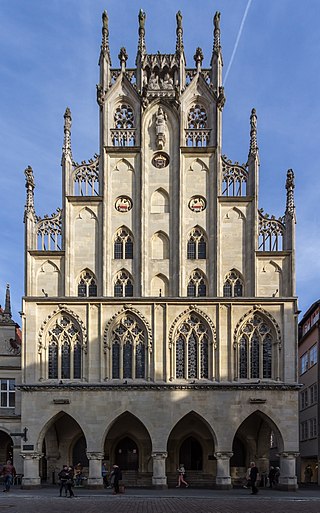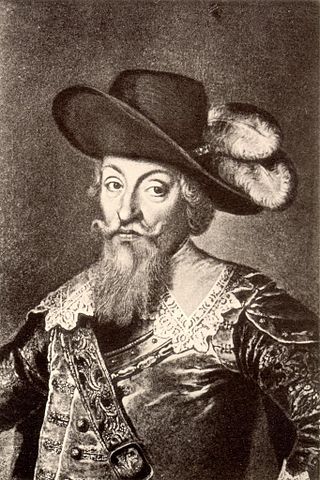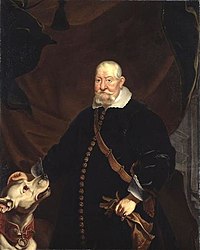
The Peace of Westphalia is the collective name for two peace treaties signed in October 1648 in the Westphalian cities of Osnabrück and Münster. They ended the Thirty Years' War (1618–1648) and brought peace to the Holy Roman Empire, closing a calamitous period of European history that killed approximately eight million people. Holy Roman Emperor Ferdinand III, the kingdoms of France and Sweden, and their respective allies among the princes of the Holy Roman Empire, participated in the treaties.

The Thirty Years' War was one of the longest and most destructive conflicts in European history, lasting from 1618 to 1648. Fought primarily in Central Europe, an estimated 4.5 to 8 million soldiers and civilians died as a result of battle, famine, or disease, while parts of present-day Germany reported population declines of over 50%. Related conflicts include the Eighty Years' War, the War of the Mantuan Succession, the Franco-Spanish War, the Torstenson War, the Dutch-Portuguese War, and the Portuguese Restoration War.

The Battle of Nördlingen took place on 6 September 1634 during the Thirty Years' War. A combined Imperial-Spanish force inflicted a crushing defeat on the Swedish-German army.

Ferdinand II was Holy Roman Emperor, King of Bohemia, Hungary, and Croatia from 1619 until his death in 1637. He was the son of Archduke Charles II of Inner Austria and Maria of Bavaria, who were devout Catholics. In 1590, when Ferdinand was 11 years old, they sent him to study at the Jesuits' college in Ingolstadt because they wanted to isolate him from the Lutheran nobles. A few months later, his father died, and he inherited Inner Austria–Styria, Carinthia, Carniola and smaller provinces. His cousin, Rudolf II, Holy Roman Emperor, who was the head of the Habsburg family, appointed regents to administer these lands.

The Edict of Restitution was proclaimed by Ferdinand II, Holy Roman Emperor in Vienna, on 6 March 1629, eleven years into the Thirty Years' War. Following Catholic military successes, Ferdinand hoped to restore control of land to that specified in the Peace of Augsburg (1555). That treaty's "Ecclesiastical Reservation" had prohibited further secularization of lands held by the Catholic church after 1555, disallowing any transfer of such lands to Protestant control. However, as the Holy Roman Empire descended into the Thirty Years' War, weak emperors had been unable to enforce this provision against Protestant encroachments.

John George I was Elector of Saxony from 1611 to 1656. He led Saxony through the Thirty Years' War, which dominated his 45-year reign.

The Heilbronn League was formed in the Free Imperial City of Heilbronn, on 23 April 1633, during the Thirty Years' War. Led by Sweden, it brought together various Protestant states in western and northern Germany. It was supported by Saxony and Brandenburg-Prussia, although they were not members.

Johann or Hans Georg von Arnim-Boitzenburg was a German Field Marshal. At different times during the Thirty Years' War, he was a Field Marshal for the Holy Roman Empire and its opponent the Electorate of Saxony. He also pursued various diplomatic tasks.

The Franco-Spanish War was fought from 1635 to 1659 between France and Spain, each supported by various allies at different points. The first phase, beginning in May 1635 and ending with the 1648 Peace of Westphalia, is considered a related conflict of the Thirty Years' War. The second phase continued until 1659, when France and Spain agreed to peace terms in the Treaty of the Pyrenees.
The Treaty of Hamburg, signed on 5 March 1638, was the ratification of the important Treaty of Wismar a full two years after it had been negotiated by Cardinal Richelieu of France and representatives of Queen Christina of Sweden. As it provided the Swedes with crucial funds to go on the offensive again, it was a major turning point of the Thirty Years' War.

The Treaty of Fontainebleau was signed on 30 May 1631 during the Thirty Years' War, at the Palace of Fontainebleau. It was a pact of mutual assistance between Maximilian I, Elector of Bavaria, and France, for a period of eight years.

The Battle of Herbsthausen, also known as the Battle of Mergentheim, took place near Bad Mergentheim, in the modern German state of Baden-Württemberg. Fought on 5 May 1645, during the Thirty Years War, it featured a French army led by Turenne, defeated by a Bavarian force under Franz von Mercy.

The Treaty of Stettin or Alliance of Stettin was the legal framework for the occupation of the Duchy of Pomerania by the Swedish Empire during the Thirty Years' War. Concluded on 25 August (O.S.) or 4 September 1630 (N.S.), it was predated to 10 July (O.S.) or 20 July 1630 (N.S.), the date of the Swedish Landing. Sweden assumed military control, and used the Pomeranian bridgehead for campaigns into Central and Southern Germany. After the death of the last Pomeranian duke in 1637, forces of the Holy Roman Empire invaded Pomerania to enforce Brandenburg's claims on succession, but they were defeated by Sweden in the ensuing battles. Some of the Pomeranian nobility had changed sides and supported Brandenburg. By the end of the war, the treaty was superseded by the Peace of Westphalia (1648) and the subsequent Treaty of Stettin (1653), when Pomerania was partitioned into a western, Swedish part, and an eastern, Brandenburgian part.

The Battle of Les Avins took place on 20 May 1635, outside the town of Les Avins, near Huy in modern Belgium, then part of the Bishopric of Liège. It was the first major engagement of the 1635 to 1659 Franco-Spanish War, a connected conflict of the Thirty Years' War.

The Treaty of Bärwalde, signed on 23 January 1631, was an agreement by France to provide Sweden financial support, following its intervention in the Thirty Years' War.

The Battle of Oldendorf on 8 July 1633 was fought as part of the Thirty Years' War between the Swedish Empire with its Protestant German allies and the Holy Roman Empire near Hessisch-Oldendorf, Lower Saxony, Germany. The result was a decisive victory for the Swedish Army and its allies.

William Louis of Nassau-Saarbrücken, was a Count of Saarbrücken.
The Hessian War, in its wider sense sometimes also called the Hessian Wars (Hessenkriege), was a drawn out conflict that took place between 1567 and 1648, sometimes pursued through diplomatic means, sometimes by military force, between branches of the princely House of Hesse, particularly between the Landgraviate of Hesse-Cassel and the Landgraviate of Hesse-Darmstadt. It was triggered by a division of inheritance following the death of the last landgrave of all Hesse, Philip I in 1567.
The imperial election of 1636 was an imperial election held to select the emperor of the Holy Roman Empire. It took place in Regensburg on December 22.

The Treaty of Compiègne, signed on 30 April 1635 Old Style, was a mutual defence alliance between France and Sweden.


















